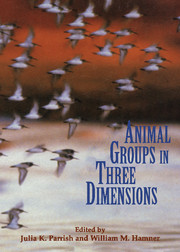Book contents
- Frontmatter
- Contents
- List of contributors
- Acknowledgments
- 1 Introduction – From individuals to aggregations: Unifying properties, global framework, and the holy grails of congregation
- Part one Imaging and measurement
- Part two Analysis
- Part three Behavioral ecology and evolution
- 11 Is the sum of the parts equal to the whole: The conflict between individuality and group membership
- 12 Inside or outside? Testing evolutionary predictions of positional effects
- 13 Costs and benefits as a function of group size: Experiments on a swarming mysid Paramesopodopsis rufa Fenton
- 14 Predicting the three-dimensional structure of animal aggregations from functional considerations: The role of information
- 15 Perspectives on sensory integration systems: Problems, opportunities, and predictions
- Part four Models
- References
- Subject index
- Taxonomic index
12 - Inside or outside? Testing evolutionary predictions of positional effects
from Part three - Behavioral ecology and evolution
Published online by Cambridge University Press: 01 June 2010
- Frontmatter
- Contents
- List of contributors
- Acknowledgments
- 1 Introduction – From individuals to aggregations: Unifying properties, global framework, and the holy grails of congregation
- Part one Imaging and measurement
- Part two Analysis
- Part three Behavioral ecology and evolution
- 11 Is the sum of the parts equal to the whole: The conflict between individuality and group membership
- 12 Inside or outside? Testing evolutionary predictions of positional effects
- 13 Costs and benefits as a function of group size: Experiments on a swarming mysid Paramesopodopsis rufa Fenton
- 14 Predicting the three-dimensional structure of animal aggregations from functional considerations: The role of information
- 15 Perspectives on sensory integration systems: Problems, opportunities, and predictions
- Part four Models
- References
- Subject index
- Taxonomic index
Summary
The schooling phenomenon presents the student of animal behavior with a paradox. On the one hand, schooling is superficially a simple phenomenon and would seem to lend itself readily to quantification and casual analysis. On the other hand, there has been a notable lack of success in relating schooling to general biological principles, and there are no really convincing ethological, ecological, or evolutionary explanations. There is no vital function to which it seems to make an efficient contribution, and it can not be immediately assigned to reproductive, defensive, or any other category of adaptive behavior.
(Williams 1964: 351)Introduction
During the three decades since the above statement was made a great deal of theoretical and empirical work has established a number of plausible functions for animal grouping. These functions typically relate to feeding efficiency or predator avoidance. Such generalizations may allow us to see overall patterns and generate hypotheses which can be tested experimentally. However, by considering the selection pressures on groups in general, there is the danger of missing some of the details. Instead, the relative advantages and disadvantages of group membership may vary in different parts of the group (Bertram 1978). For example, although individuals at the edge of a group may be more likely to be preyed upon than those at the center, they may also be more likely to obtain food. The costs and benefits to an organism as a function of location within the group has rarely been assessed. I hope to convince the reader that groups are not homogeneous units, and that different selective pressures operating in different locations within a group lead to position preferences by its members.
Information
- Type
- Chapter
- Information
- Animal Groups in Three DimensionsHow Species Aggregate, pp. 174 - 193Publisher: Cambridge University PressPrint publication year: 1997
Accessibility standard: Unknown
- 17
- Cited by
